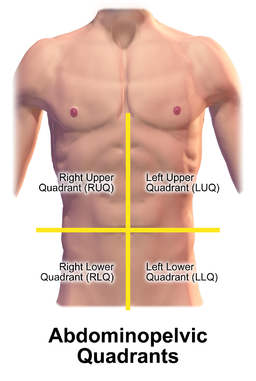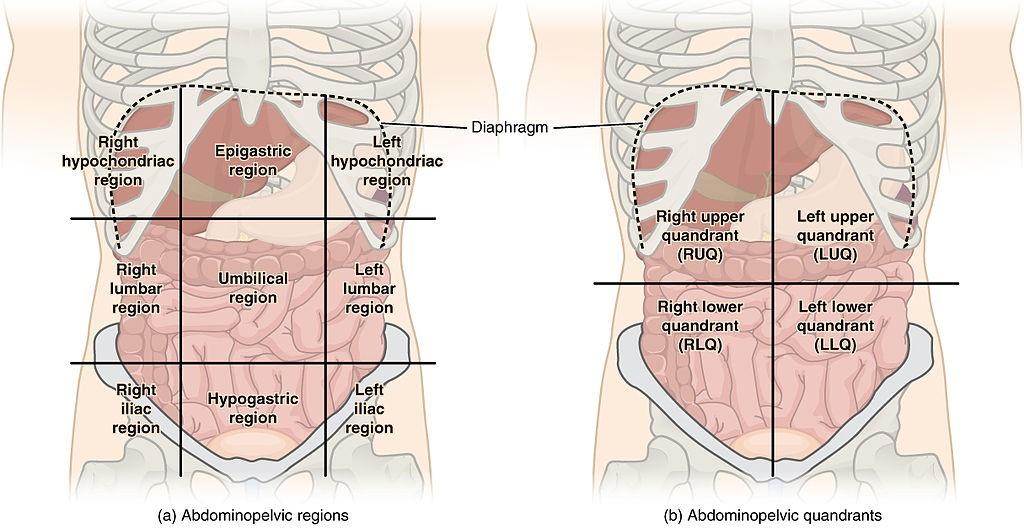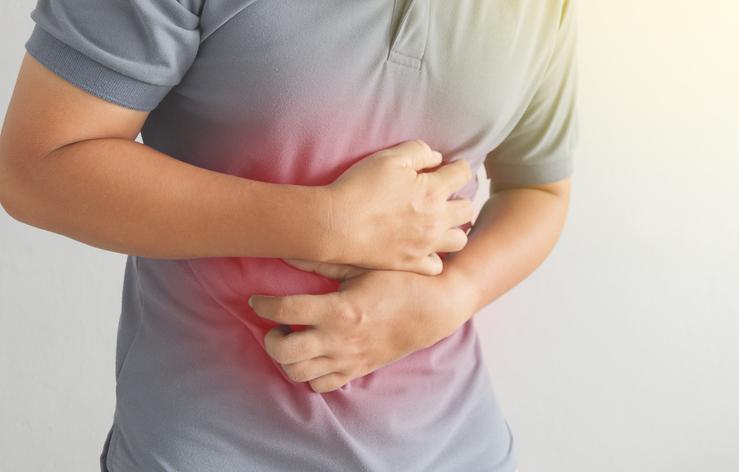Schmerzen im rechten unteren Quadranten
Begutachtet von Dr. Rachel Hudson, MRCGPZuletzt aktualisiert von Dr. Caroline Wiggins, MRCGP Zuletzt aktualisiert am 15. Oktober 2024
Erfüllt die Anforderungen des Patienten redaktionelle Richtlinien
- HerunterladenHerunterladen
- Teilen Sie
- Sprache
- Diskussion
Right lower quadrant (RLQ) pain is tummy (abdominal) pain that is mainly in the lower half on the right-hand side. It is sometimes also called right iliac fossa (RIF) pain, although this really means pain in a smaller area in the lower right corner of your tummy.
In diesem Artikel:
Lesen Sie unten weiter
Where is my right lower quadrant?
The right lower quadrant (RLQ) is a section of your tummy (abdomen). Look down at your tummy, and mentally divide the area from the bottom of your ribs down to your pubic hair into four quarters. The quarter on your right side below your belly button is your RLQ.
Bauch-Becken-Quadranten

By Blausen.com staff (2014). “Blausen Medical 2014”. WikiJournal of Medicine 1 (2). DOI:10.15347/wjm/2014.010. ISSN 2002-4436.
What is in my right lower quadrant?
Regionen des abdominalen Quadranten

OpenStax, CC BY 3.0, über Wikimedia Commons
Dünndarm (Ileum).
The connection between your small bowel and your large bowel (caecum).
Appendix.
First part of your large bowel (colon).
Right ureter (at the back of the other organs).
Right ovary and Fallopian tube.
And don't forget the skin, muscles and nerves of that area.
Lesen Sie unten weiter
Common causes of right lower quadrant pain
The list of causes of right lower quadrant pain is extremely long but the following are some of the more common possibilities (they are not in order of how common they are):
Verstopfung
If your guts are full of poo (faeces) this can cause discomfort anywhere in your tummy.
Normalerweise werden Sie merken, dass Sie Ihren Darm nicht so oft wie sonst öffnen.
Ihr Kot wird hart und pelletartig sein.
Weitere Informationen finden Sie in der separaten Packungsbeilage Verstopfung.
Gastroenteritis und Lebensmittelvergiftung
These conditions can cause diarrhoea.
They may also make you sick (vomit).
Pain may be anywhere in the abdomen (tummy).
Nach jedem Durchfall kann der Schmerz für eine Weile nachlassen.
See the separate leaflets called Gastroenteritis and Food poisoning for more information.
Reizdarmsyndrom (IBS)
This is very common.
Es neigt dazu, krampfartige Bauchschmerzen zu verursachen.
Sie verursacht häufig Blähungen.
Sie kommt und geht und kann mit Durchfall und/oder Verstopfung verbunden sein.
See the separate leaflet called Irritable bowel syndrome for more information.
Blinddarmentzündung
Usually the pain starts in the middle of the tummy over the period of an hour or so.
Typically it moves to the RLQ over the next few hours.
It tends to be sharper if you cough or move suddenly.
It may ease a bit if you pull your knees up to your chest.
You may also feel sick (nausea) and go off your food. You may vomit.
You may have a temperature (fever) and will feel generally unwell.
If the appendix bursts then pain can be severe and all over your tummy.
See the separate leaflet called Appendicitis for more information.
Divertikulitis
Dabei handelt es sich um eine Entzündung eines Beutels oder mehrerer Beutel, die Menschen mit Divertikelkrankheit in ihrem Darm haben.
Usually pain from diverticular disease is in the left lower quadrant (LLQ) but it can be on the right or sometimes can be felt higher up.
It usually comes with a temperature and a change in bowel habit (opening your bowels more or less often than usual for you).
Eingeklemmte Leisten- oder Oberschenkelhernie
A right inguinal or femoral hernia happens when a piece of bowel or other tissue from inside the tummy pushes through a weakness in the muscles of the tummy wall near the right groin.
Das kann auf beiden Seiten passieren.
Wenn das, was durchgedrungen ist, stecken bleibt und nicht mehr in den Bauch zurückgleiten kann, ist es eingeschlossen (inkarzeriert).
If it happens on the right-hand side, there will be a tender swelling in the right groin.
Er verursacht Schmerzen in der Leiste und im Bauch, in der Regel auf der Seite des Bruchs, aber er kann auch Schmerzen im gesamten Bauch verursachen.
Es ist üblich, sich zu übergeben (Erbrechen).
Weitere Informationen finden Sie in der separaten Packungsbeilage "Hernie".
Can kidney infection cause right lower quadrant pain?
A kidney infection can cause pain anywhere along your urinary tract. So this could be anywhere from the loin in your back, around the side and down to the right lower quadrant. It would be unusual to have pain just in the right lower quadrant, more common for it to also be in the right loin/right upper quadrant.
You may notice that it hurts when you pass urine and that you need to pass urine more often. You may also have a temperature or feel shivery.
Weitere Informationen finden Sie in der separaten Packungsbeilage Niereninfektion (Pyelonephritis).
Lesen Sie unten weiter
Causes of right lower quadrant pain in women
Mittelschmerz
This is pain when you release an egg (ovulation), which is usually about halfway between two periods.
It can be very severe and stop you short but usually eases over several minutes.
It will only be felt on one side but can be right or left. You may get similar pain on the same or other side of your tummy at the same point in another cycle.
Beckenentzündungskrankheit
Pain is usually on both sides but may just be in the RLQ.
Die Schmerzen sind beim Sex schlimmer.
There is abnormal bleeding, so bleeding not just at period time but in between periods and often after sex.
You may feel generally unwell and feverish.
There is usually a vaginal discharge, which may be smelly.
Weitere Informationen finden Sie in der separaten Packungsbeilage "Beckenentzündung".
Verdrehter Eierstock
Twisted ovary (ovarian torsion) usually only occurs if a fluid-filled sac (cyst) has developed on the right ovary.
Der Schmerz kann konstant oder intermittierend sein.
Symptoms can be similar to appendicitis.
Weitere Informationen finden Sie in der separaten Packungsbeilage "Eierstockzyste".
Endometriose
Manchmal kann die Endometriose ständige Schmerzen im Unterbauch verursachen, obwohl sie normalerweise kurz vor, während und für kurze Zeit nach der Periode schlimmer sind.
Pain is usually across the lower part of the tummy but it can be just on the right side.
See the separate leaflet called Endometriosis for more information.
Ektopische Schwangerschaft
You should always see a doctor urgently if there is any chance that you may be pregnant and are experiencing right lower quadrant pain. You could have an ectopic pregnancy
.
Causes of right lower quadrant pain in men
Any pain coming from the right side of the scrotum can cause pain in the RLQ but usually the pain in the scrotum will be worse.
Verdrehung des Hodens
Torsion of the testicle (testis) causes severe pain in the scrotum and severe lower quadrant pain, usually on one side.
Am häufigsten sind Jungen im Teenageralter betroffen, aber auch junge erwachsene Männer können betroffen sein.
Ungewöhnlich ist sie ab einem Alter von 25 Jahren, kann aber jeden Mann in jedem Alter treffen.
Der Hoden ist sehr empfindlich.
You should seek urgent medical advice.
Weitere Informationen finden Sie im separaten Merkblatt Hodentorsion.
Epididymo-orchitis
Bei der Epididymo-Orchitis handelt es sich um eine Entzündung des Hodens und/oder der ihn umgebenden Eileiter (Epididymis).
It is caused by a germ (infection).
Die betroffene Seite des Hodensacks schwillt an und wird sehr rot und empfindlich.
Weitere Informationen finden Sie in der separaten Packungsbeilage Epididymo-Orchitis.
Other possible causes of right lower quadrant pain
Entzündliche Darmerkrankung
Crohn's disease and ulcerative colitis are forms of inflammatory bowel disease (IBD). IBD is not to be confused with irritable bowel syndrome (IBS) which is very different. These conditions cause the lining of the gut to become inflamed. Diarrhoea (sometimes with blood mixed in) is usually the main symptom.
Morbus Crohn
Any part of the gut can be affected and the pain depends on which part is affected.
The most common place for it to start is at the end of the small intestine (ileum) causing RLQ pain.
This is where the appendix is and the symptoms can be very like appendicitis.
See the separate leaflet called Crohn's disease for more information.
Colitis ulcerosa
Diarrhoea is often mixed with mucus or pus.
Blood mixed with the diarrhoea is common.
The tummy (abdominal) pain is typically crampy.
See the separate leaflet called Ulcerative colitis for more information.
Colon cancer
Colon cancer is one of the most common cancers in the UK (in contrast, cancer of the small intestine is rare).
Although it can affect any part of the large bowel (colon), it commonly affects the last part (descending colon) which is on the left-hand side.
Pain is more likely to be in the left lower quadrant (LLQ) than the RLQ.
There is usually a change in how often you need to open your bowels and you may notice that you have lost weight, without trying.
See the separate leaflet called Bowel cancer (Colorectal cancer) for more information.
Nierensteine
Nierensteine sind harte Steine, die sich in der Niere, in der Harnröhre (dem Harnleiter), die den Urin aus der Niere ableitet, oder in der Harnblase bilden können.
A stone that passes into the ureter draining urine from your right kidney may cause pain that starts in your right loin and spreads (radiates) to your groin and RLQ, or into your testicle (testis) or penis if you are a man.
You may notice blood in your urine.
Weitere Informationen finden Sie in der separaten Packungsbeilage "Nierensteine".
Gürtelrose
In einigen Fällen kann die Gürtelrose Schmerzen verursachen, bevor ein blasiger Ausschlag auftritt.
Pain tends to be sharp or burning.
Sie fühlen sich vielleicht nicht ganz Sie selbst.
The tummy (abdomen) is a common place for shingles rash.
Weitere Informationen finden Sie in der separaten Packungsbeilage Gürtelrose (Herpes Zoster).
Abdominales Aortenaneurysma
Ein Bauchaortenaneurysma ist eine Schwellung des größten Blutgefäßes des Körpers (der Aorta) im Bauchraum.
It doesn't usually cause any symptoms but can occasionally cause pain before it bursts. The pain is usually felt in your back or the side of your tummy (abdomen) but it can occasionally be felt in the right (or left) lower quadrant.
Weitere Informationen finden Sie in der separaten Broschüre Abdominales Aortenaneurysma.
Was könnte es sonst sein?
These lists of possible causes for RLQ are by no means exhaustive and there are many other conditions that can cause pain in the RLQ. Problems in your spine or back could be 'referred'. Referred pain in this situation means that it is coming from your back but you feel the pain around the front of your body.
Muscular pulls and sprains can also affect you in the tummy area. If this is the case, moving the particular muscle would make the pain worse, whereas if you were to lie completely still, it wouldn't hurt.
Wann Sie einen Arzt aufsuchen sollten
If you have a pain which doesn't settle, you will probably need to see a health professional to help you figure out the cause. See a doctor urgently if you:
Sie haben sehr starke Schmerzen.
Sie haben anhaltende Übelkeit (Erbrechen).
Sie haben in letzter Zeit Gewicht verloren, ohne es zu versuchen.
Have persistent diarrhoea.
Schwindel, Benommenheit, Ohnmacht oder Atemnot.
Are bringing up blood or have blood in your poo (faeces).
Sie haben eine Abweichung von Ihren üblichen Stuhlganggewohnheiten. Das bedeutet, dass Sie Ihren Darm mehr oder weniger oft als gewöhnlich öffnen, was zu Durchfall oder Verstopfung führen kann.
Could be pregnant.
How is right lower quadrant pain diagnosed?
Your doctor will narrow the (enormous) field of possible RLQ pain diagnoses by talking with you and examining you. They may be able to find the cause simply by doing so. For example, if they find the typical rash of shingles, you will need no further tests to find the cause.
The doctor will certainly need to feel your tummy (abdomen) in the area you have the pain, but may also need to examine other parts too, such as the rest of your tummy. You will probably be asked to provide a sample of urine, to rule out kidney problems.
You may well have to go for blood tests. These might include tests to:
Überprüfen Sie die Funktion Ihrer Leber und Nieren.
Schließen Sie jede Entzündung oder Infektion in Ihrem Körper aus.
Achten Sie auf Anämie.
Check your sugar level.
What other tests might be needed for right lower quadrant pain?
Dann kommt es darauf an, was die Untersuchung und die oben genannten Tests ergeben haben. In manchen Fällen sind keine weiteren Tests erforderlich - zum Beispiel, wenn Ihr Arzt sicher ist, dass Sie an Verstopfung oder Gürtelrose leiden.
If a problem with your large bowel is suspected, you may need an examination with a tube with a camera put into your large bowel (a colonoscopy). A computerised tomography (CT) scan or an ultrasound scan may be helpful to look for diverticula and to look at your kidneys.
These tests are also used in women to look at the ovary and tubes. In some cases an X-ray of the tummy may be useful. Further tests include other 'scopes' (such as a sigmoidoscopy) and other scans (such as a magnetic resonance imaging (MRI) scan).
If it is thought you have appendicitis, an ectopic pregnancy (women) or a torsion of your testicle (testis) - men, you may only have one or two of these tests before having emergency surgery to treat your problem.
Niemand braucht alle diese Tests, und manche Menschen brauchen vielleicht gar keinen.
How to treat right lower quadrant pain
There is no single answer to this until you know what the cause of your pain is. See the relevant leaflet for the condition with which you have been diagnosed. Treatments for a few of the causes of RLQ pain are briefly discussed below.
Constipation can be treated with medicines, but often changes to your diet are needed to prevent it happening again.
Gastroenteritis usually doesn't need any treatment, other than drinking plenty of fluid to compensate for all that is being lost. Occasionally when germs (bacteria) which can be treated with antibiotics are causing the infection, an antibiotic may help.
Appendicitis may be treated with an operation (an appendicectomy).
Ectopic pregnancy is usually treated by an operation but medical treatment is now more common. This avoids the need for surgery and means the tube is less likely to be permanently damaged.
Shingles. The pain and rash settle on their own in time, but some people may be advised to take an antiviral tablet to reduce the risk of long-term nerve pain from the shingles.
Kidney infections are treated with antibiotics. Mild infections can be treated with antibiotics at home. If you are very unwell you may need admission to hospital for antibiotics and fluids through a drip (intravenously).
Kidney stones. Small kidney stones pass on their own eventually, in which case you will need to drink plenty of fluids and take strong painkillers. Larger kidney stones may need one of a number of procedures done to break them up or remove them altogether.
Wie sind die Aussichten?
Again this depends entirely on the cause of the pain. Some conditions settle very quickly on their own (for example, gastroenteritis), or with the help of antibiotics (for example, a kidney infection).
Others can be cured with surgery, such as appendicitis or torsion of the testicle (testis). Some are long-term conditions, for which there is no cure although there are treatments, such those used for people who have Crohn's disease. Your doctor should be able to give you an idea of the outlook (prognosis) once a diagnosis has become clear.
Patient wählt aus für Unterleibsschmerzen

Gesundheit der Verdauung
Mesenteriale Adenitis
Mesenteriale Adenitis bedeutet geschwollene (entzündete) Lymphdrüsen im Bauch (Abdomen), die Bauchschmerzen verursachen. Sie wird manchmal auch Mesenteriallymphadenitis genannt. Das Mesenterium ist der Teil des Bauches, in dem sich die Drüsen befinden. Adenitis bedeutet entzündete Lymphdrüsen.
von Dr. Doug McKechnie, MRCGP

Gesundheit der Verdauung
Schmerzen im linken oberen Quadranten
Dieses Merkblatt befasst sich mit Schmerzen, die im oberen Teil des Bauches (Abdomen) auf der linken Seite auftreten können. Es geht um mögliche Ursachen, wie eine Diagnose gestellt werden kann und welche Behandlung möglich ist.
von Dr. Caroline Wiggins, MRCGP
Weiterführende Literatur und Referenzen
- Cartwright SL, Knudson MPBewertung von akuten Bauchschmerzen bei Erwachsenen. Am Fam Physician. 2008 Apr 1;77(7):971-8.
- Cartwright SL, Knudson MPDiagnostische Bildgebung bei akuten Bauchschmerzen bei Erwachsenen. Am Fam Physician. 2015 Apr 1;91(7):452-9.
- Krebsverdacht: Erkennung und Überweisung; NICE guideline (2015 - last updated May 2025)
Lesen Sie unten weiter
Artikel Geschichte
Die Informationen auf dieser Seite wurden von qualifizierten Klinikern verfasst und von Fachleuten geprüft.
Nächste Überprüfung fällig: 14. Oktober 2027
15. Oktober 2024 | Neueste Version
Zuletzt aktualisiert von
Dr. Caroline Wiggins, MRCGP
Peer-Review durch
Dr. Rachel Hudson, MRCGP

Fragen, teilen, verbinden.
Stöbern Sie in Diskussionen, stellen Sie Fragen, und tauschen Sie Erfahrungen zu Hunderten von Gesundheitsthemen aus.

Fühlen Sie sich unwohl?
Beurteilen Sie Ihre Symptome online und kostenlos
Sign up to the Patient newsletter
Your weekly dose of clear, trustworthy health advice - written to help you feel informed, confident and in control.
By subscribing you accept our Privacy Policy. You can unsubscribe at any time. We never sell your data.